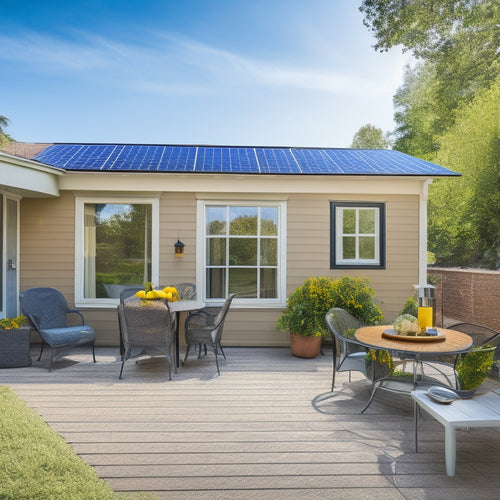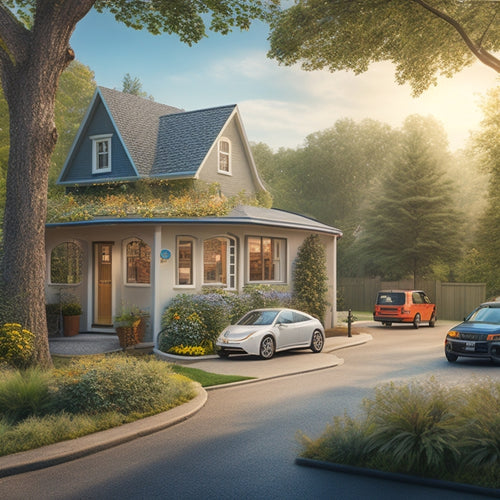
Understanding the Typical Cost of Installing Solar Panels
Share
You can expect to pay between $12,500 and $17,500 for a typical residential solar panel system, which translates to $2.50 to $3.50 per watt, depending on factors like system size, equipment quality, and installation company. This cost range is influenced by various factors, including financing options, installation warranties, and location-based incentives. Understanding these factors is essential in determining the overall cost of your solar panel installation. By grasping these details, you'll be better equipped to make an informed decision about investing in solar energy and accessing its long-term benefits.
Key Takeaways
- The average cost of installing solar panels ranges from $2.50 to $3.50 per watt, with a typical residential system costing $12,500 to $17,500.
- System size, equipment quality, and installation company are key factors that affect the overall cost of solar panel installation.
- Financing options, including flexible payment plans and low-interest loans, are available to make solar panel installation more affordable.
- Installation warranties are essential for ensuring the performance and durability of solar panels, and can provide peace of mind for homeowners.
- Long-term savings from reduced energy bills, increased property value, and enhanced energy independence can outweigh the upfront costs of solar panel installation.
National Average Solar Panel Costs
As you venture into the world of renewable energy, clarity on costs becomes paramount. You're likely wondering what the national average solar panel costs are, and how they'll impact your wallet.
On average, the cost of solar panels in the United States ranges from $2.50 to $3.50 per watt. With a typical residential solar panel system requiring around 5,000 watts, the total cost would fall between $12,500 and $17,500.
However, this cost can vary depending on factors such as system size, quality of equipment, and installation company.
It's essential to evaluate solar panel financing options, as many providers offer flexible payment plans and low-interest loans.
Additionally, look for installation warranties that cover the system's performance and durability. A thorough warranty can provide peace of mind and protect your investment.
Factors Affecting Solar Installation Prices
You'll find that several factors influence the cost of installing solar panels, and understanding these variables is essential to estimating the expense.
Two key considerations are the system size, which directly impacts the number of panels and equipment needed, and location-based incentives, such as tax credits and rebates, that can greatly reduce the upfront cost.
System Size Matters
The size of your solar panel system plays a significant role in determining the overall installation cost, with larger systems generally requiring more equipment and labor.
As a homeowner, you'll want to evaluate the size of your system carefully, as it will impact not only the upfront cost but also your long-term energy savings.
A larger system will typically generate more electricity, but it will also increase your installation financing costs. On the other hand, a smaller system may be more budget-friendly, but it may not provide enough power to meet your energy needs.
Here are three key factors to evaluate when determining the ideal size of your solar panel system:
- Your energy usage: How much electricity do you use on a daily basis?
- Your roof size: How much space do you have available for solar panels?
- Your budget: What can you afford to spend on installation and financing?
Location-Based Incentives
Your location plays a crucial role in determining the cost of installing solar panels, with varying incentives and policies affecting the final price tag. Depending on where you live, you may be eligible for state or local government incentives, such as tax credits or rebates, which can greatly reduce the upfront cost of installation.
For example, some states offer property tax exemptions or sales tax exemptions for solar panels, while others provide cash rebates or performance-based incentives.
In addition, local governments may have their own policies and regulations that impact the cost of installation. You may need to obtain installation permits, which can vary in cost depending on your location.
Moreover, your location can also affect your access to solar financing options, such as low-interest loans or power purchase agreements. Understanding the location-based incentives and policies in your area can help you maneuver the cost of installing solar panels and make the most of your investment.
Cost Breakdown of Solar Panel Systems
You'll find that the cost of a solar panel system can be broken down into two main categories: system hardware costs and labor and overheads.
System hardware costs include the expenses associated with the physical components of your system, such as solar panels, inverters, and mounting equipment.
Labor and overheads, on the other hand, cover the costs of installation, maintenance, and other expenses related to the installation process.
System Hardware Costs
Solar panel systems comprise several key components, each contributing to the overall cost of installation. As you consider investing in solar energy, it's crucial to understand the system hardware costs that make up a considerable portion of the total expense.
The type and quality of solar panels you choose will greatly impact your system's hardware costs. You'll need to decide between monocrystalline, polycrystalline, or thin-film panels, each with its own price point and efficiency level.
Additionally, the installation method you select will also influence costs. For instance, roof-mounted systems are generally more expensive than ground-mounted ones.
Here are three key system hardware components that affect costs:
- Solar panels: The cost of the panels themselves, including the type and quality you choose.
- Mounting hardware: The cost of the racking and tracking systems that secure the panels to your roof or ground.
- Inverters and electrical components: The cost of the inverters that convert DC power to AC, as well as other electrical components like wiring and connectors.
Labor and Overheads
Nearly half of the total installation cost goes towards labor and overheads, making them a significant component of the overall expense. As you consider installing solar panels, it's vital to understand the labor costs involved. The labor market plays an important role in determining the installation efficiency and ultimately, the cost.
Labor costs can vary depending on the location, complexity of the installation, and the installer's experience. On average, labor costs range from $2,000 to $5,000 for a typical residential installation. Overheads, which include administrative costs, marketing expenses, and profit margins, add to the overall expense.
Here is a breakdown of the labor and overheads costs:
| Component | Cost Range | Description |
|---|---|---|
| Labor Costs | $2,000 - $5,000 | Installation, maintenance, and repair costs |
| Overheads | $1,000 - $3,000 | Administrative costs, marketing expenses, and profit margins |
| Permits and Inspections | $500 - $2,000 | Costs associated with obtaining necessary permits and inspections |
| Miscellaneous | $500 - $2,000 | Additional costs, such as travel and accommodation expenses for installers |
Pricing Differences by Region
The cost of installing solar panels varies greatly depending on the region you're in. This regional pricing difference is due to various factors, including local labor costs, permits, and installation requirements.
As you consider installing solar panels, it's vital to understand how your location affects the overall cost.
One major contributor to regional pricing differences is installation variability. Different regions have unique installation requirements, such as specialized mounting systems for high-wind areas or snow-load capacity for regions with heavy snowfall. These requirements increase the cost of installation.
Here are three key factors that contribute to regional pricing differences:
-
Local labor costs: Labor costs vary greatly depending on the region, with urban areas typically having higher labor costs than rural areas.
-
Permitting and inspection fees: Permitting and inspection fees differ by region, with some areas having more stringent requirements than others.
-
Installation requirements: Regional installation requirements, such as those mentioned earlier, can greatly impact the overall cost of installation.
Understanding these regional pricing differences is vital to getting an accurate estimate for your solar panel installation.
Incentives and Rebates for Solar
Your decision to go solar can be greatly influenced by the incentives and rebates available to you. Federal tax credits, for instance, allow you to claim a considerable portion of your solar panel installation costs as a credit on your taxes.
In addition, state incentives, such as rebates or tax exemptions, can provide additional savings. You may also be eligible for utility rebates, which are offered by your utility company to encourage the adoption of renewable energy.
Moreover, financing options, such as loans or power purchase agreements, can help make solar more affordable. You may also be able to take advantage of solar grants, installation discounts, or community programs that offer special rates for group purchases.
Another benefit is the ability to sell renewable energy certificates, which represent the environmental attributes of your solar energy production.
Long-Term Savings of Solar Energy
Long-Term Savings of Solar Energy
Frequently, solar panel owners enjoy significant long-term savings on their energy bills. As you generate your own clean energy, you'll rely less on the grid, reducing your utility bills. Over time, these savings can add up, offsetting the initial investment in your solar panel system.
Here are three key ways you'll benefit from solar energy's long-term savings:
-
Lower Energy Bills: With solar panels, you'll produce your own energy, reducing your reliance on the grid and subsequently lowering your energy bills.
-
Increased Property Value: Installing solar panels can increase your property value, making your home more attractive to potential buyers if you decide to sell in the future.
-
Long-Term Energy Independence: Solar energy provides a sustainable source of power, reducing your dependence on fossil fuels and contributing to a cleaner environment, which aligns with the sustainability benefits you'll experience.
Frequently Asked Questions
Can I Install Solar Panels on a Rental Property?
You'll need to review your renter agreements to determine if installation permissions are granted, and if so, what requirements and restrictions apply, before installing solar panels on a rental property.
Do Solar Panels Increase My Property Taxes?
You're wondering if solar panels will increase your property taxes. Typically, they won't; however, if your property value increases due to the installation, your tax assessment might rise, resulting in higher taxes, but this varies by location and local policies.
Can I Install Solar Panels on a Metal Roof?
You can install solar panels on a metal roof, leveraging its advantages like durability and water-tightness, but be prepared to tackle installation challenges like ensuring secure fastening and accommodating roof penetrations, ensuring a watertight seal.
How Long Does a Solar Panel Installation Take?
You're probably wondering how long it'll take to capture the sun's power, and surprisingly, the installation process is faster than you think! The typical installation timeline ranges from a few days to a few weeks, depending on the complexity of the installation process.
Can I Sell Excess Energy Back to the Grid?
You can sell excess energy back to the grid through net metering, which allows you to offset your consumption and earn credits; with attractive energy buyback rates, you'll reap the benefits of generating more power than you need.
Conclusion
As you stand on the threshold of utilizing solar energy, the cost of installation might seem intimidating. But with a clear understanding of the national average, factors that affect pricing, and regional differences, you can make an informed decision. Imagine the warm rays of sunlight converted into electricity, powering your home, and slashing your energy bills. With incentives and rebates, the initial investment will pay off, and the long-term savings will be as bright as the sun itself, illuminating a sustainable future.
Related Posts
-

10 Tips to Buy Affordable Solar Panels Online
When purchasing affordable solar panels online, you'll want to research reputable retailers, compare prices, and chec...
-

Why Nearby EV Conversion Shops Matter to You
Having a nearby EV conversion shop means you'll experience the benefits of a more personalized, convenient, and susta...
-

What Role Do Unicycles Play in Urban Transport?
As you navigate through congested city streets, unicycles emerge as a viable solution, slashing carbon emissions by u...


